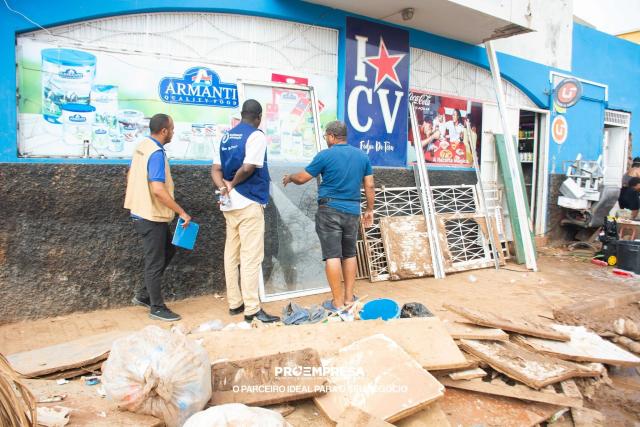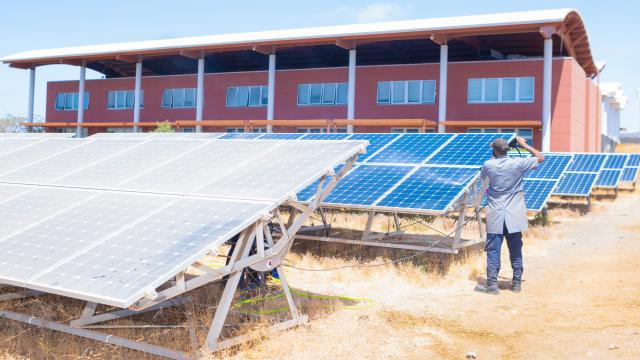In Cabo Verde, LuxDev works to improve access to water and sanitation, enhance youth employability, strengthen the healthcare sector, and support the country’s energy transition.
LuxDev in Cabo Verde
Development cooperation between Luxembourg and Cabo Verde began in the late 1980s, with the first general cooperation agreement signed in 1993. LuxDev has maintained a presence in the country since 2000.
Over the years, Luxembourg has engaged in five multi-year Indicative Cooperation Programmes with Cabo Verde, primarily focused on healthcare, education, vocational training and employment, water and sanitation, energy transition, and integrated local development.
Since 2021, the Indicative Cooperation Programme V "Development – Climate – Energy" has aimed to support the country’s socio-economic and environmental policies while continuing to strengthen these key sectors.
LuxDev’s initiatives align with Cabo Verde’s national development strategies and poverty reduction efforts. The Agency works closely with government ministries and local authorities to ensure effective, impactful, and locally owned programmes.

© Sonia SEMEDO
Challenges in Cabo Verde: economic diversification and climate resilience
Although Cabo Verde transitioned from a Least Developed Country to a lower-middle-income country in 2008, it still faces significant challenges. The economy heavily relies on tourism, fossil fuels, and international aid, making it highly vulnerable to external shocks and climate change.
Poverty remains a pressing issue. Limited formal job opportunities push many citizens into precarious employment in the informal sector, where wages are low and social protections are minimal. As a result, many young people seek better prospects abroad, contributing to high emigration rates.
-
30% of the population
living below the poverty line
Gallery viewer
Additionally, infrastructure deficits impact key sectors such as water, energy, and transportation. Water scarcity and challenging agricultural conditions threaten food security. The country also faces frequent droughts and limited freshwater resources, making climate resilience a critical concern.
Addressing these challenges requires coordinated efforts to strengthen infrastructure, diversify the economy, develop human capital, and improve food security, ultimately fostering a more sustainable and resilient Cabo Verde.
Our activities in Cabo Verde
LuxDev’s programmes in Cabo Verde play a key role in addressing the country’s development challenges.
-
Expanding access to clean water and sanitation
We support universal access to safe, affordable drinking water and high-quality sanitation services. These efforts are crucial for public health and sustainable development, particularly benefiting the most vulnerable communities.
-
Enhancing youth employability
Our vocational training and employment initiatives focus on equipping young people with skills for the tourism sector, a key driver of Cabo Verde’s economy. The programmes also promote innovation and entrepreneurship among young professionals.
-
Strengthening the healthcare sector
We work to reinforce the public healthcare system, ensuring that it can better meet the needs of the population and improve overall health outcomes.
-

Supporting the energy transition
In collaboration with Cabo Verde’s climate policy goals for 2025, the programmes strengthen climate governance and promote renewable energy solutions. These efforts support the country’s transition to a more sustainable and resilient energy system.
Gallery viewer
Key figures in Cabo Verde
-
EUR 22,679,672
disbursed in Cabo Verde in 2024
Distribution of disbursements by sector in 2024
Evolution of activities in Cabo Verde
Projects in Cabo Verde
-

In execution Cabo Verde
Cabo Verde’s climate action planning at local level
Environment and climate change
Cabo Verde’s climate action planning at local level -

In execution Cabo Verde
Support programme for vocational training, employment and employability
Education, vocational training and employment
Support programme for vocational training, employment and employability -

In execution Cabo Verde
Sectoral budget support for employment and employability in Cabo Verde
Education, vocational training and employment
Sectoral budget support for employment and employability in Cabo Verde -

In execution Cabo Verde
Support for rehabilitation efforts following Tropical Storm Erin
Water and sanitation
Support for rehabilitation efforts following Tropical Storm Erin -

In execution Cabo Verde
Support for the production, analysis and dissemination of quality statistics in Cabo Verde
Governance
Support for the production, analysis and dissemination of quality statistics in Cabo Verde -

In execution Cabo Verde
Enabling direct access to the Green Climate Fund for climate finance for Cabo Verde
Environment and climate change
Enabling direct access to the Green Climate Fund for climate finance for Cabo Verde -

In execution Cabo Verde
Climate action programme
Environment and climate change
Climate action programme -

In execution Cabo Verde
Cross-cutting support for the Indicative Cooperation Programme ‘Development - Climate - Energy’
Others
Cross-cutting support for the Indicative Cooperation Programme ‘Development - Climate - Energy’ -
In execution Cabo Verde
Sectoral budget support in the health sector in Cabo Verde
Health
Sectoral budget support in the health sector in Cabo Verde -

In execution Cabo Verde
Water and sanitation sector support programme
Water and sanitation
Water and sanitation sector support programme -

In execution Cabo Verde
Strengthening the Cabo Verde climate governance framework
Environment and climate change
Strengthening the Cabo Verde climate governance framework -
In execution Cabo Verde
Energy transition support programme
Environment and climate change
Energy transition support programme





















